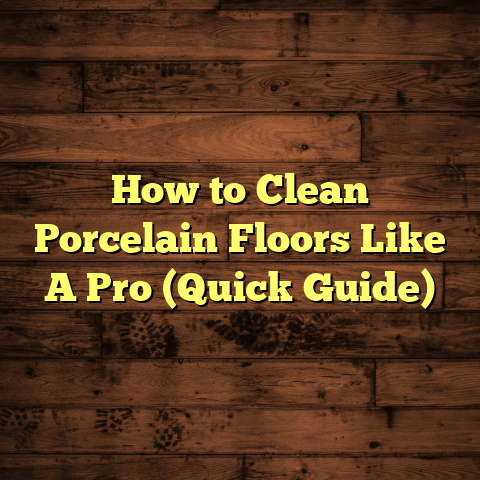Floor Warping: What It Is and How To Fix It [Fast]
When working with flooring, safety is my top priority. Whether it’s during installation or maintenance, ensuring a safe environment for myself and my clients is essential. I’ve seen firsthand how accidents can happen, whether from slipping on unprotected surfaces or tripping over tools left lying around. That’s why I always make sure to have a clean workspace, proper equipment, and, of course, the right protective gear.
Understanding Floor Warping
Floor warping is something I’ve encountered many times in my career. It can be a real headache for both contractors and homeowners, so let’s break it down.
What exactly causes warping? Well, it’s often due to fluctuations in humidity and temperature. For example, I once worked on a project in a coastal area where the humidity levels were constantly changing. This made the wooden floors expand and contract, leading to noticeable warping. Have you experienced something like that? It can be frustrating!
The Impact of Floor Warping
Warping can significantly affect the aesthetics and functionality of your flooring. When I was called to assess a situation in a client’s home, they were distraught about their once-beautiful hardwood floors now resembling a wavy ocean. The warped boards not only looked unsightly but also created gaps and uneven surfaces that could lead to further damage.
Types of Warping
- Cupping: The edges of the boards rise higher than the center.
- Crowning: The center of the board is elevated, making the edges lower.
- Bowing: The entire board curves along its length.
Each type presents unique challenges and requires different approaches for resolution.
My Personal Experiences with Warping
There was one particular job where I had just finished installing beautiful oak flooring in a living room. Two weeks later, the homeowner called me back—there was significant cupping! After inspecting, I realized that they had a leaky pipe in the basement, causing high moisture levels. This experience taught me the importance of checking moisture levels before installation.
On another occasion, I worked on an older home with a history of water damage. The client wanted to install hardwood floors, but I advised them to consider engineered wood instead. Why? Engineered wood is more stable and resistant to moisture changes compared to solid hardwood. This decision saved them from potential warping issues down the line.
Addressing Floor Warping
When dealing with warped floors, here are some steps that have worked for me:
- Identify the Source: Always start by figuring out what caused the warping in the first place. Is it humidity? A leak?
- Dry It Out: If moisture is the culprit, I recommend using dehumidifiers or fans to dry out the space.
- Repair or Replace: Depending on the severity of the warping, you may need to sand down the affected areas or replace boards entirely.
- Prevent Future Issues: After repairs, I advise clients to invest in humidity control solutions, like dehumidifiers or proper ventilation systems.
Installation Tips to Prevent Warping
Prevention is always better than cure! Here are some tips I share with clients to avoid warping issues:
- Acclimate Your Flooring: Always let your flooring materials sit in the room where they will be installed for at least 48 hours beforehand. This helps them adjust to the local humidity and temperature.
- Use Quality Materials: Cheaper materials may warp more easily. Invest in high-quality flooring options that are more resistant to changes.
- Install Properly: Ensure that expansion gaps are left around the perimeter of the room to allow for movement.
Tools and Resources
In my work, I’ve found tools like FloorTally incredibly helpful. It allows me to estimate costs accurately while considering potential issues like warping. For instance, when calculating expenses for a recent job, I inputted all dimensions and material types into FloorTally. It took into account possible waste and unexpected costs related to any repairs needed due to warping.
Using such tools not only saves time but also helps me present detailed budgets to clients upfront. They appreciate this transparency, especially when discussing potential issues like floor warping.
Successes and Challenges
One challenge I faced occurred during a large commercial project where several rooms needed flooring installed simultaneously. Despite my best efforts to monitor humidity levels closely, we experienced unexpected fluctuations due to an HVAC issue in the building. As a result, several areas showed signs of warping shortly after installation.
To rectify this situation, we had to replace some boards and reinforce our moisture barriers on future jobs at that location. This experience taught me that even when things seem well under control, staying vigilant is necessary.
On the flip side, a recent residential project went exceptionally well because we took extra precautions. The homeowners were thrilled with their new bamboo floors, which are naturally resistant to moisture fluctuations compared to traditional hardwoods.
Maintenance Tips for Preventing Warping
Once your flooring is installed, keeping it in good condition is crucial:
- Regular Cleaning: Sweep or vacuum regularly to remove debris that can scratch surfaces.
- Humidity Control: Maintain indoor humidity levels between 30% and 50%.
- Avoid Excessive Water: Be careful with mopping—too much water can seep into seams and cause problems.
Cost Considerations
If you’re worried about costs related to floor warping, consider budgeting for preventative measures from the start. Using FloorTally helps me present realistic estimates for both initial installation and potential future maintenance costs.
For example, if I foresee potential issues due to high humidity in a specific area, I can include additional costs for dehumidifiers or moisture barriers upfront so clients aren’t caught off guard later.
Conclusion: Learning from Experience
Floor warping can be a frustrating issue for anyone who loves their flooring. Through my experiences—both good and bad—I’ve learned that prevention is essential. Understanding your environment and being proactive about moisture control can save you from costly repairs down the line.
Each flooring option has its pros and cons regarding warping resistance. Engineered wood tends to hold up better than solid hardwood in humid conditions, while tile remains unaffected by moisture altogether.
If you’re considering new flooring, weigh your options carefully and think about your environment. And remember—if you ever encounter warping issues, don’t hesitate to reach out to a professional who can help guide you through the process!
Deep Dive into Floor Warping Causes
To truly understand floor warping, let’s take a closer look at its main causes:
- Moisture Imbalance: Wood is hygroscopic; it absorbs moisture from the air or surrounding materials. In humid conditions, wood expands; in dry conditions, it contracts. Such movements can lead to warping if not properly managed.
- Temperature Fluctuations: Extreme temperatures can also cause expansion or contraction in flooring materials. During hot weather, materials can swell; when it cools down, they might shrink.
- Poor Installation Practices: If flooring isn’t installed correctly—like insufficient acclimation time or improper fastening—it can lead to warping over time.
- Subfloor Issues: An unstable or uneven subfloor can contribute significantly to warping problems. If the subfloor has moisture problems or isn’t level, this will affect how the flooring sits above it.
- Environmental Factors: External factors such as leaks from plumbing systems or roof problems can introduce moisture into your flooring system unexpectedly.
Technical Specifications for Flooring Materials
When working with different flooring types, understanding their specifications can help mitigate warping risks:
Hardwood
- Moisture Content: Ideally between 6% and 8% before installation.
- Expansion Rate: Generally 0.1% per 10°F temperature change.
Engineered Wood
- Moisture Resistance: More stable than solid wood due to plywood layers.
- Installation Method: Can be floated or glued down; floating installations often allow for better expansion accommodation.
Laminate Flooring
- Moisture Resistance: Typically more resistant than solid hardwood but still not waterproof.
- Expansion Gap Requirement: Typically 1/4″ around all edges for expansion.
Tile Flooring
- Moisture Resistance: Completely waterproof if installed correctly.
- Thermal Expansion: Minimal thermal expansion compared to wood; however, grout lines need proper sealing.
Case Study: Residential Project with Engineered Wood
I recall working on a residential project where the homeowner wanted engineered wood flooring installed throughout their new home. Given the climate conditions in their area—high humidity—I recommended this option over solid hardwood due to its stability.
After acclimating the boards for several days before installation, we proceeded with care while laying them out in staggered patterns for aesthetic appeal and structural integrity. Six months later, they called me back—not because of issues, but simply to say how pleased they were with their decision! This success reinforced my belief in choosing appropriate materials based on environmental conditions.
Real-Life Challenges Encountered
Despite my best efforts over the years, not every project has gone perfectly smooth:
- Old Homes with Hidden Issues: On one job in an older home, we discovered hidden water damage once we pulled up old carpet—the subfloor was compromised! We had to replace it entirely before continuing with our installation—a significant unexpected cost that reminded me of the importance of thorough inspections before starting work.
- Client Miscommunication: In another instance, I miscommunicated with a client about their desired finish for their hardwood floor installation. The client wanted a matte finish while I assumed they wanted gloss based on their previous discussions about aesthetics! This led us backtrack on some work already completed—adding time and costs that neither of us had planned for.
Practical Tips for Homeowners
If you’re a homeowner looking into new flooring or facing potential warping issues, here are some tips based on my experiences:
- Regular Inspections: Don’t wait until you notice problems—regularly inspect your flooring for signs of wear or moisture issues.
- Choose Wisely: When selecting materials, think about your lifestyle! If you have pets or kids running around, consider durable options like laminate or engineered wood that can withstand everyday wear without showing damage quickly.
- Educate Yourself: Understanding your environment will help you make informed decisions about what kind of flooring works best for you based on climate and usage patterns in various rooms throughout your home.
- Communicate Openly with Contractors: Always discuss your concerns openly with your flooring contractor—whether it’s about aesthetic preferences or potential risk factors related to moisture exposure!
Tools I Use Daily
As a contractor who values efficiency and accuracy in my work processes daily—I rely heavily on specific tools beyond just FloorTally:
- Moisture Meters: These are invaluable for assessing wood moisture levels before installation; they help ensure we’re not starting off on the wrong foot!
- Laser Levels: Ensuring everything is level during installation is critical; laser levels help avoid complications later due to uneven surfaces leading to warped floors down line!
- Air Quality Monitors: Keeping track of humidity levels within homes helps manage indoor climates better—not just benefiting flooring but overall home health!
Conclusion Revisited
Floor warping poses challenges that require proactive measures—from understanding environmental factors impacting various types of flooring materials through proper installation techniques down towards regular maintenance practices afterwards!
By sharing my experiences—both successes and setbacks—I hope this extensive discussion empowers you as a homeowner or contractor facing similar situations moving forward! Always remember that staying informed goes hand-in-hand with making sound decisions regarding your home’s beautiful floors!


![Toilet Flange & Tile Height: Quick Fixes [For High Floors]](https://floortally.com/wp-content/uploads/2025/01/Toilet-Flange-Tile-Height-Fixing-High-Tile-Floors.png)
![Is Interlocking Vinyl Wood Flooring Right For Your Home? [Quick Install Guide]](https://floortally.com/wp-content/uploads/2025/01/Is-Interlocking-Vinyl-Wood-Flooring-Right-For-Your-Home.png)


![How Often Should You Clean Floors? [Protect Your Investment]](https://floortally.com/wp-content/uploads/2025/01/How-Often-Should-I-Clean-My-Floors.png)